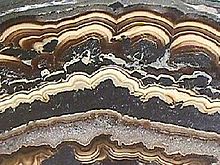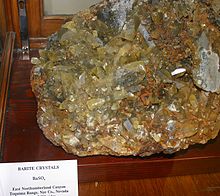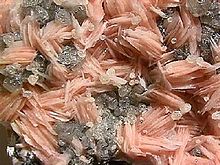- Baryte
-
Baryte (barite) 
Baryte crystals on dolomite from Cumbria, England (size: 5.4×4.6 cm)General Category Sulfate mineral, barite group Chemical formula BaSO4 Strunz classification 07.AD.35 Dana classification 28.03.01.01 Crystal symmetry Orthorhombic (2/m 2/m 2/m) dipyramidal Unit cell a = 8.884(2) Å, b = 5.457(3) Å, c = 7.157(2) Å; A = 4 Identification Color Colorless, white, light shades of blue, yellow, grey, brown Crystal habit Tabular parallel to base, fibrous, nodular to massive Crystal system Orthorhombic Cleavage Perfect cleavage parallel to base and prism faces: {001} Perfect, {210} Perfect, {010} Imperfect Fracture Irregular/uneven Tenacity Brittle Mohs scale hardness 3-3.5 Luster Vitreous, pearly Streak White Diaphaneity transparent to opaque Specific gravity 4.3–5 Density 4.48 g/cm3[1] Optical properties biaxial positive Refractive index nα = 1.634–1.637
nβ = 1.636–1.638
nγ = 1.646–1.648Birefringence 0.012 Fusibility 4, yellowish green barium flame Diagnostic features white color, high specific gravity, characteristic cleavage and crystals Solubility low References [2][3][4][5] Baryte, or barite, (BaSO4) is a mineral consisting of barium sulfate.[2] The baryte group consists of baryte, celestine, anglesite and anhydrite. Baryte itself is generally white or colorless, and is the main source of barium. Baryte and celestine form a solid solution (Ba,Sr)SO4.[1]
Contents
Names and history
The radiating form, sometimes referred to as Bologna Stone, attained some notoriety among alchemists for the phosphorescent specimens found in the 17th century near Bologna by Vincenzo Casciarolo.[6]
The name baryte is derived from the Greek word βαρύς (heavy). The American spelling barite[2] is used by the USGS[7] and more often used in modern Scientific journals including those published by the Netherlands-based Elsevier journals. The International Mineralogical Association adopted "barite" as the official spelling when it formed in 1959[citation needed], but recommended adopting the older "baryte" spelling in 1978,[8] notably ignored by the Mineralogical Society of America. The American Petroleum Institute specification API 13/ISO 13500 which governs baryte for drilling purposes does not refer to any specific mineral, but rather a material that meets that specification, in practice this is usually the mineral baryte.
The term "primary baryte" refers to the first marketable product, which includes crude baryte (run of mine) and the products of simple beneficiation methods, such as washing, jigging, heavy media separation, tabling, flotation. Most crude baryte requires some upgrading to minimum purity or density. Baryte that is used as an aggregate in a "heavy" cement is crushed and screened to a uniform size. Most baryte is ground to a small, uniform size before it is used as a filler or extender, an addition to industrial products, or a weighting agent in petroleum well drilling mud.
Other names
Baryte has gone by other names such as barytine,[8] barytite,[8] schwerspath,[8] barytes,[2] Heavy Spar,[2] or tiff.[3]
Mineral associations and locations
Baryte occurs in a large number of depositional environments, and is deposited through a large number of processes including biogenic, hydrothermal, and evaporation, among others.[1] Baryte commonly occurs in lead-zinc veins in limestones, in hot spring deposits, and with hematite ore. It is often associated with the minerals anglesite and celestine. It has also been identified in meteorites.[9]
In the USA, baryte has been found at locations in Cheshire, Connecticut, De Kalb, New York, Fort Wallace, New Mexico, and is quarried in Arkansas, Connecticut, Virginia, North Carolina, Georgia, Tennessee, Kentucky, Nevada, and Missouri.[2] Localities outside the USA include Baia Sprie, Romania, Westmoreland, Cornwall, Cumberland, Derbyshire, Durham, Muirshiel (where zinc was also retracted), Perthshire, Argyllshire and Surrey in the UK,[2] China, India, Morocco, Peru, Chile, Liberia, Turkey, Thailand, Ireland (where it was actively mined on Benbulben[10]), Canada, Iran, Brazil, Greece, and Barberton Mountain Land, South Africa.[11]
The major barite producers (in thousand tonnes, data for 2010) are as follows: China (3,600), India (1,000), United States (670), Morocco (460), Iran (250), Turkey (150) and Kazakhstan (100).[12]
Uses
Some 77% worldwide is used as a weighting agent for drilling fluids in oil and gas exploration to suppress high formation pressures and prevent blowouts. As a well is drilled, the bit passes through various formations, each with different characteristics. The deeper the hole, the more barite is needed as a percentage of the total mud mix. An additional benefit of barite is that it is non-magnetic and thus does not interfere with magnetic measurements taken in the borehole, either during logging-while-drilling or in separate drill hole logging. Barite used for drilling petroleum wells can be black, blue, brown or gray depending on the ore body. The barite is finely ground so that at least 97% of the material, by weight, can pass through a 200-mesh (75-μm) screen, and no more than 30%, by weight, can be less than 6 μm diameter. The ground barite also must be dense enough so that its specific gravity is 4.2 or greater, soft enough to not damage the bearings of a tricone drill bit, chemically inert, and containing no more than 250 milligrams per kilogram of soluble alkaline salts.[7]
Other uses are in added-value applications which include filler in paint and plastics, sound reduction in engine compartments, coat of automobile finishes for smoothness and corrosion resistance, friction products for automobiles and trucks, radiation-shielding cement, glass ceramics and medical applications (for example, a barium meal before a contrast CAT scan). Baryte is supplied in a variety of forms and the price depends on the amount of processing; filler applications commanding higher prices following intense physical processing by grinding and micronising, and there are further premiums for whiteness and brightness and color.[7]
Historically baryte was used for the production of barium hydroxide for sugar refining, and as a white pigment for textiles, paper, and paint.[2]
Although baryte contains a "heavy" metal (barium), it is not considered to be a toxic chemical by most governments because of its extreme insolubility.
Paleothermometry
In the deep ocean, away from continental sources of sediment, pelagic baryte crystallizes out and forms a significant amount of the sediments. Since baryte has oxygen, systematics in the δ18O of these sediments have been used to help constrain paleotemperatures for oceanic crust. Similarly the variations in sulfur isotopes are also being exploited.[13]
References
 This article incorporates public domain material from the United States Geological Survey document "Barite".
This article incorporates public domain material from the United States Geological Survey document "Barite".- ^ a b c Hanor, J. (2000). "Barite-celestine geochemistry and environments of formation". Reviews in Mineralogy (Washington, DC: Mineralogical Society of America) 40: 193–275. ISBN 0-939950-52-9.
- ^ a b c d e f g h Dana, James Dwight; Ford, William Ebenezer (1915). Dana's Manual of Mineralogy for the Student of Elementary Mineralogy, the Mining Engineer, the Geologist, the Prospector, the Collector, Etc. (13 ed.). John Wiley & Sons, Inc.. pp. 299–300. http://www.archive.org/details/danasmanualmine00fordgoog.
- ^ a b Barite at Mindat
- ^ Webmineral data for barite
- ^ Baryte, Handbook of Mineralogy
- ^ History of the Bologna stone
- ^ a b c M. Michael Miller Barite, 2009 Minerals Yearbook
- ^ a b c d "International Mineralogical Association: Commission on New Minerals and Mineral Names". Mineralogical Magazine 38 (293): 102–5. March 1971. doi:10.1180/minmag.1971.038.293.14.
- ^ Rubin, Alan E. (March 1997). "Mineralogy of meteorite groups". Meteoritics & Planetary Science 32 (2): 231–247. Bibcode 1997M&PS...32..231R. doi:10.1111/j.1945-5100.1997.tb01262.x.
- ^ Ben Bulben. Mhti.com. Retrieved on 2011-05-05.
- ^ Duchač, K. C; Hanor, J. S. (September 1987). "Origin and timing of the metasomatic silicification of an early Archaean komatiite sequence, Barberton Mountain Land, South Africa". Precambrian Research 37 (2): 125–146. doi:10.1016/0301-9268(87)90075-1. ISSN 0301-9268.
- ^ Barite, USGS 2010 Mineral Commodity Summaries
- ^ Kastner, Miriam (30 March 1999). "Oceanic minerals: Their origin, nature of their environment, and significance". Proc. Natl. Acad. Sci. U.S.A. 96 (7): 3380–7. Bibcode 1999PNAS...96.3380K. doi:10.1073/pnas.96.7.3380. PMC 34278. PMID 10097047. http://www.pnas.org/content/96/7/3380.full.
Categories:- Barium minerals
- Sulfate minerals
- Orthorhombic minerals
Wikimedia Foundation. 2010.





